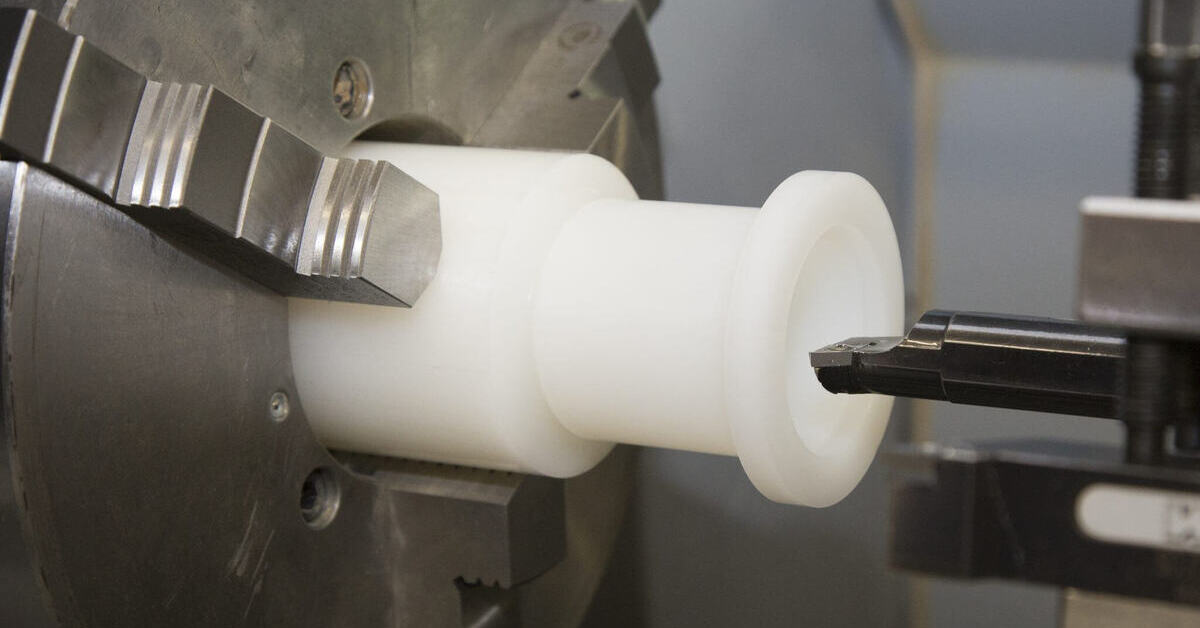Typical Plastic Parts Manufacturing Processes
Since plastic materials are available in different dimensions, shapes, colors, and durabilities, manufacturers and designers employ other manufacturing techniques to produce these plastics effectively to desired shapes and sizes. We will discuss some of these standard manufacturing processes in this section:
CNC Machining
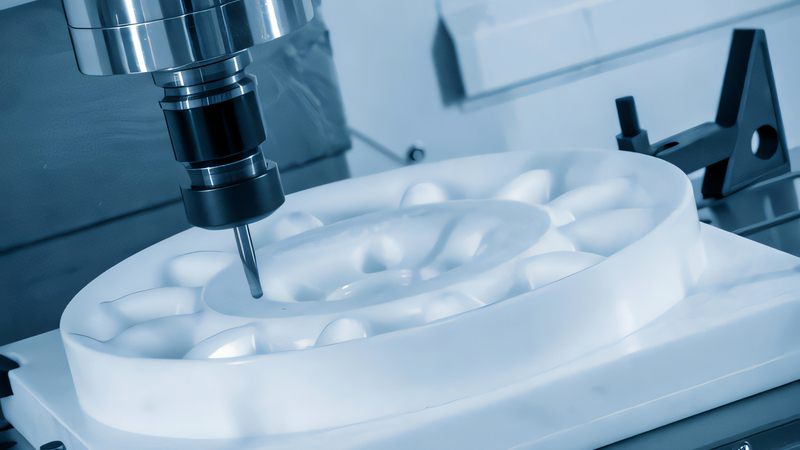
The CNC machining process uses computer numerical control to dictate the movement of cutting tools like CNC lathes, mills, and drills. These CNC tools gradually remove material from the block to achieve a specific shape. CNC machining comprises operations such as milling, turning, grinding, routing, and drilling.
The CNC machining technology is ideal for creating plastic parts that are difficult or near impossible to mold. CNC machining offers high precision, making it the go-to choice for prototyping and manufacturing certain end-use products in the medical, aerospace, and automotive industries.
However, the machining cost per part may increase significantly due to the complexities of the plastic part. Additionally, it can be challenging, if not impossible, to achieve specific geometric shapes like curved interior channels using CNC machining processes.
3D Printing
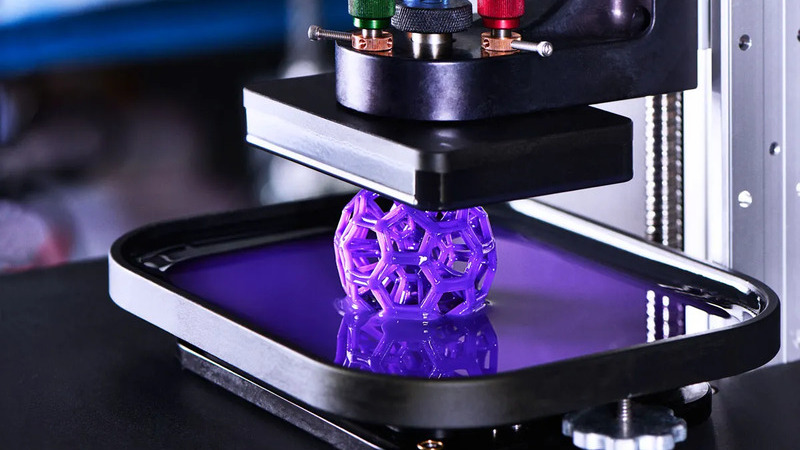
3D printing technology uses computer-aided designs and models to produce three-dimensional parts by adding the production material layer by layer until the part is fully formed. 3D printing is an additive manufacturing process with fewer design limitations. As a result, it has a competitive edge over other manufacturing processes in producing complex shapes.
3D printing easily creates intricate design features like curved internal channels, unlike CNC machining, where you must evaluate how the mill head will assess tight spots and the appropriate tool size needed to create fine details in the part’s geometry. Furthermore, 3D printing makes parts as solid pieces instead of multiple components of an assembly.
Injection Molding

The plastic injection molding process involves injecting liquid thermoplastic resin into the empty hole of a forming die. The mold used in this process can be hardened steel or aluminum. These molds can have geometrically complex structures, allowing tight tolerances, high iterative accuracy, and superior surface finish, making the process ideal for high-volume production runs.
The liquid resin takes the mold’s internal shape. Once the resin cools, it becomes solid and ready for ejection. More so, injection molding is a reliable large-scale manufacturing process because it can make identical parts as quickly as possible and at a low cost with an excellent surface finish.
Thermoforming
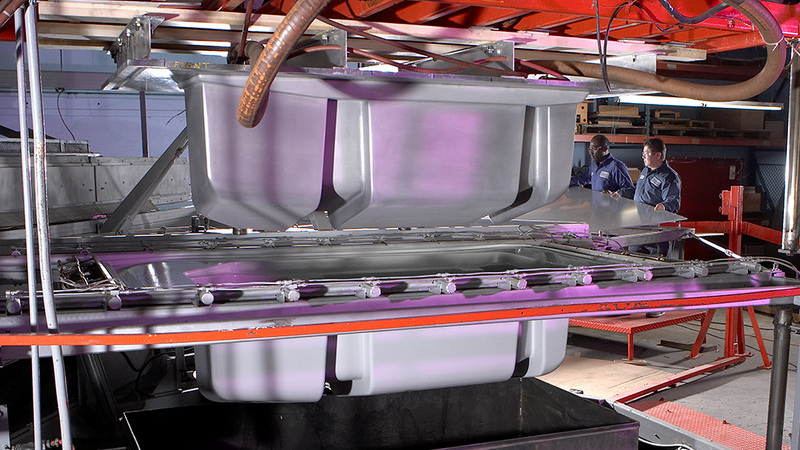
The thermoforming process is a type of vacuum forming that involves placing a thin or thick gauge plastic sheet over a die and heating it to a temperature that makes the material flexible. Then, vacuum pressure pulls the sheet down and forms it into the desired shape as the material is stretched over the die’s surface. Thermoforming is economical and doesn’t produce toxic chemicals or fumes.
This plastic part production technique works with simple dies and simple equipment. Manufacturers often use thermoforming to make plastic cups, clamshell packaging, lids, and boxes. The automotive sector also uses this technique to complete auto body parts in thicker gauge materials. However, thermoforming plastics are the only material compatible with the process. Thermosets are unsuitable because they soften when exposed to high heat and solidify after cooling. Additionally, it doesn’t offer high precision as the material shrinks after cooling.
Extrusion Molding

The extrusion molding shares characteristics similar to the plastic injection molding process. It needs melted plastics to create parts of the desired dimensions. However, the extrusion systems use force to deliver the molten plastic into the mold through a die that shapes the plastic into a permanent structure.
Door jambs, plastic pipes, hoses, gutters, straws, and other symmetrical parts are typical items made with extrusion molding. However, extrusion-made products often have low tooling and production costs because of their simpler shapes.
Vacuum Casting
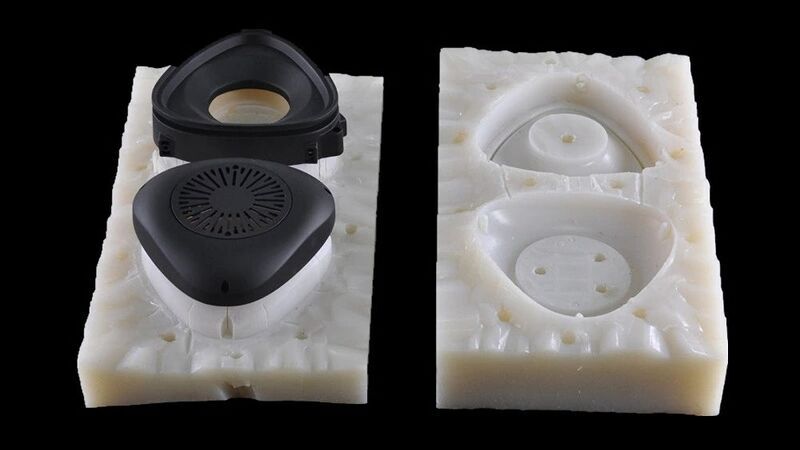
Vacuum casting or urethane casting is a reliable plastic manufacturing process that makes precise plastic parts with superior quality. It is suitable for creating rapid prototypes without investing too much in materials or tools. Polyurethane vacuum casting involves making a silicone mold from a master pattern of the intended product. A cavity is formed within the mold after removing the master model, one which you have to fill with liquid plastic resin to create a copy of the original. Vacuum pressure pulls out the air in the mold, ensuring the molten material fills the mold evenly without air bubbles.
This plastic part manufacturing process provides excellent surface finish quality and fine detail. The pourable resins used in vacuum casting can imitate various engineering plastic grades. However, these pourable resins are quite different from their counterparts used in plastic injection molding. However, it would help to note that the vacuum casting tools are fragile and wear faster because they react to chemicals in resin.
Roto-Molding
Rotational molding uses a mold tool with a core side and a cavity side to make plastic parts. The manufacturing procedure differs from injection molding because the plastic powder goes into the mold’s cavity first, after which you will place it in an oven. The mold rotates slowly on two axes while it is being heated. During this process, gravity helps to attach the plastic material to the walls and achieve the correct thickness.
You must extract the mold from the oven and cool it slowly to avoid molding complications like warpage. However, complete mold cooling can take several minutes, after which you can open the tool and remove the part to begin the next cycle.
Roto-molding is well-suited for producing plastic parts with concave, hollow, or large shapes specifically for outdoor use, i.e., storage tanks, tubs, or canoes. Rotational molded parts are stress-free and usually durable. Although the tools used in this process are inexpensive, they don’t last more than a few cycles before they wear out. It is important to note that the precision level is average. Hence, it is not the best choice for precision forming.
Extrusion Blow Molding
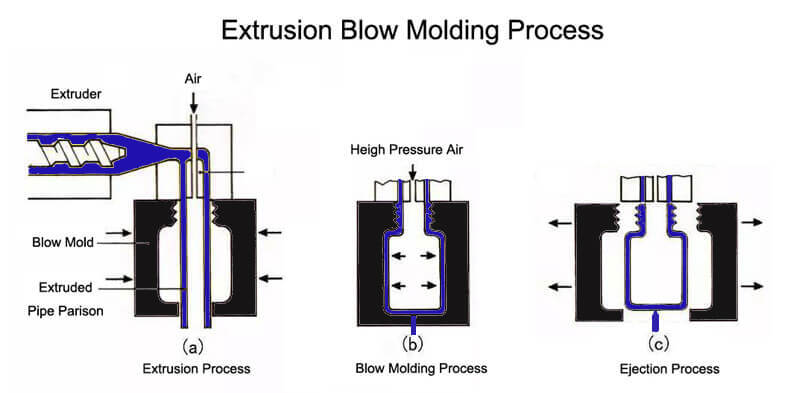
Extrusion blow is an ideal manufacturing method used to produce thin-walled, hollow plastic products like plastic bottles and drinking cups. The extrusion of a hollow tube, known as a parison, is the first step in the extrusion blow molding process. You must put the molten plastic in a two-piece clamshell mold and close it to allow the parison to inflate like a balloon and fill the empty cavity.
The plastic solidifies quickly because of the mold’s water-cooled walls. Hence, you can eject the molded part faster. Although the process is fast, and the tools are easy to produce, it is not suitable for molding parts with complex features or tight tolerance requirements.
Reaction Injection Molding (RIM)
Reaction injection molding is another widely used plastic manufacturing process in the automotive industry due to its ability to create lightweight parts with tough skin. You can easily paint this skin to make dashboards, body panels, and other automotive components.
However, thermoforming plastics are not compatible with RIM. Thermosetting plastics are more suitable for the process because they can withstand irreversible chemical reactions in the mold. It makes them expand like foam and fill the mold cavity. The plastic takes its final shape after the chemical reaction is done. Nevertheless, it would help to note that the process is more labor intensive, increasing the piece per price even though its tooling costs range from low to moderate.
Compression Molding
Compression molding involves pre-heating the raw material, usually polyurethane or polyurethane materials, and placing it in the open cavity of a die. Then, you must close the die with a plug or cap and apply heat and pressure to cure the plastic. The process is suitable for making plastic parts like gaskets, keypad switches, O-rings, and other flexible, thin-walled parts.
The compression molding process is economical and doesn’t waste material. However, it can be challenging to control the consistency of the final product. Hence, it would be best to be careful when preparing the initial mold design. Moreover, compression molding dies are easy to make and relatively inexpensive compared to plastic injection mold tools.
| Manufacturing Process | Advantages | Disadvantages |
|---|---|---|
| CNC Machining |
|
|
| 3D Printing |
|
|
| Injection Molding |
|
|
| Thermoforming |
|
|
| Extrusion Molding |
|
|
| Vacuum Casting |
|
|
| Extrusion Blow Molding |
|
|
Common Materials Used in Plastic Parts Manufacturing Processes
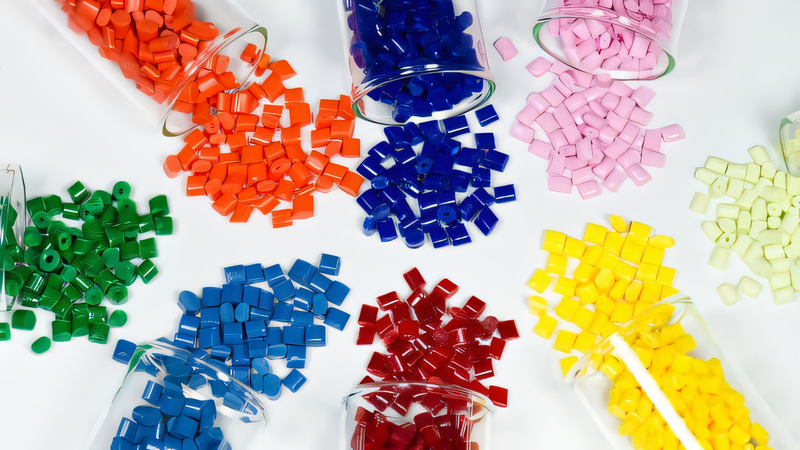
Plastics are a family of versatile CNC machining materials with over ten thousand types of commercially available plastic resins. Each of these plastics is specially formulated with specific chemical and mechanical properties.
Even though the list seems endless, here are some of the commonly used classes of plastic raw materials widely used in producing industrial and consumer products:
- Acrylic
- ABS
- Polyethylene terephthalate (PET)
- Polyether-ether-ketone (PEEK)
- Polyurethane (PU)
- Polyamide
- polyvinyl Chloride (PVC)
- Polyethylene (PE)
- Polycarbonate (PC)
- Polypropylene (PP)
- Thermoplastic Rubber
However, plastic manufacturers sometimes add carbon fiber or glass to enhance the strength and stiffness. You can also mix two or more resins to integrate their properties. Moreover, these categories of plastics offer a wide range of physical properties, including lightweight, chemical resistance, optical clarity, flexibility, toughness, strength, and impact resistance. Typical plastic use include playground equipment, medical devices, automotive part, window frames and food packaging.
Considerations for Effective Plastic Parts Manufacturing
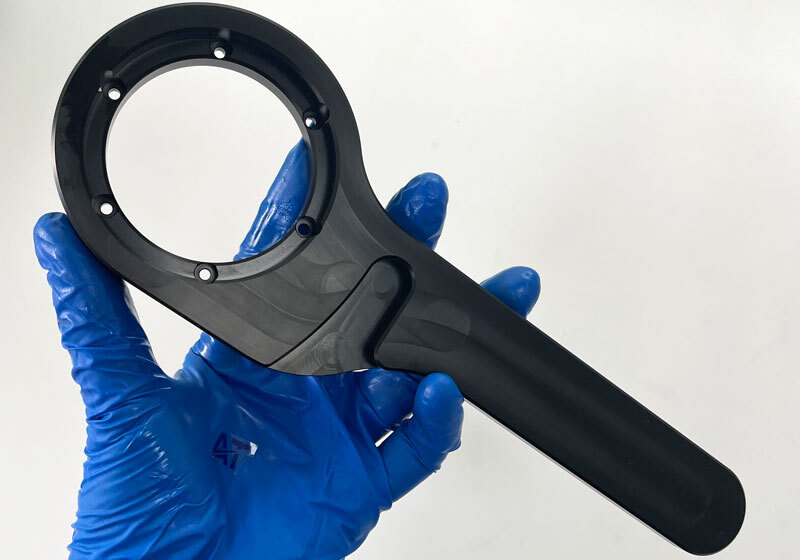
Since there are different plastic parts manufacturing processes, it is crucial to choose the ideal one for your project. We will discuss some helpful considerations for an effective plastic manufacturing process:
Choose the Right Material
The application of any part is a primary consideration when determining the ideal material for its production. What extreme working conditions or strain will your plastic parts have to withstand? However, the aesthetic and functional requirements must maintain an equilibrium with your machining budget.
Therefore, you have to evaluate the demands of the intended application and then juxtapose them with the available manufacturing processes. Strategically selecting a plastic manufacturing process can improve the desired characteristics of some materials in some instances. For example, you can produce elastic, low-durometer polyurethane parts efficiently with urethane casting. However, it can be challenging to achieve with 3D printing technology.
Lead Time
The time required to finish the plastic products is another primary consideration in plastic manufacturing. Some plastic manufacturing processes produce the first few parts within a day, while other large-scale processes include tooling and setup, which may be time-consuming.
Form
Several plastic parts have varying features and tolerance requirements. As such, it is advisable to consider these factors before selecting a manufacturing process for your plastic products. The design geometry of the part may determine the ideal plastic manufacturing process. In addition, you may have to optimize the design for manufacturing (DFM) to ensure a more cost-effective production.
Volume and Cost
The total volume of required parts is another major factor in plastic manufacturing. Large-scale plastic part production often attracts high initial tooling costs, but the parts can be inexpensive per piece. Meanwhile, low-volume production may have additional set-up costs.
However, the cost per part is often higher because of the shorter manufacturing cycles depending on the chosen manufacturing process.
AT-Machining: Your Reliable Plastic Parts Manufacturer

AT-Machining is a one-stop CNC machine shop with modern CNC machines. We are your best bet whenever you need a reliable plastic parts manufacturing expert to handle your manufacturing processes. Our experts have experience manufacturing different plastic and metal parts for various industries.
As an ISO-certified CNC manufacturer, we ensure your CNC plastic parts meet stringent quality standards. AT-Machining offers extensive manufacturing solutions, including plastic manufacturing and other value-added services for all your prototyping and high-volume production requirements. Trust us to carry you along with all information related to your project. Contact us today to talk to an expert about how we can assist you with your project.
Conclusion
Plastic manufacturing involves using any of the many production processes to make products from plastic resins. Knowing the different plastic processing methods is essential to choosing the best plastic manufacturing process. This article has discussed in detail all you need to know to select the specific manufacturing processes for your plastic parts.

